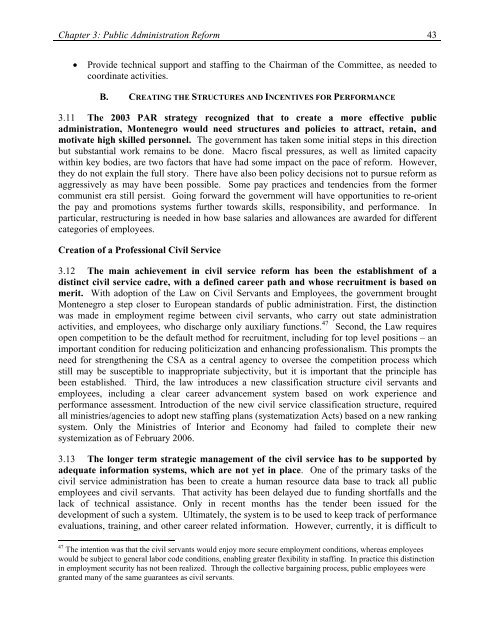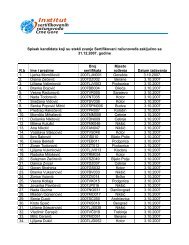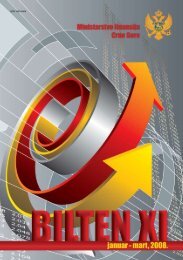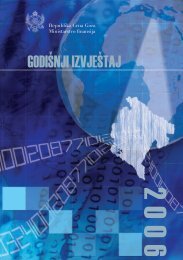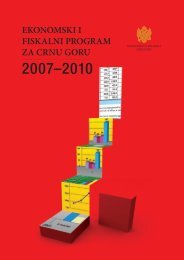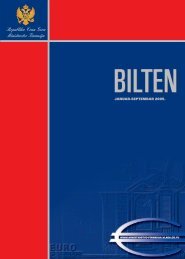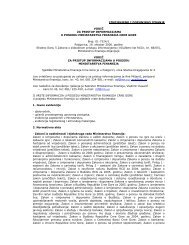Republic of Montenegro: Public Expenditure and ... - Vlada Crne Gore
Republic of Montenegro: Public Expenditure and ... - Vlada Crne Gore
Republic of Montenegro: Public Expenditure and ... - Vlada Crne Gore
You also want an ePaper? Increase the reach of your titles
YUMPU automatically turns print PDFs into web optimized ePapers that Google loves.
Chapter 3: <strong>Public</strong> Administration Reform 43<br />
• Provide technical support <strong>and</strong> staffing to the Chairman <strong>of</strong> the Committee, as needed to<br />
coordinate activities.<br />
B. CREATING THE STRUCTURES AND INCENTIVES FOR PERFORMANCE<br />
3.11 The 2003 PAR strategy recognized that to create a more effective public<br />
administration, <strong>Montenegro</strong> would need structures <strong>and</strong> policies to attract, retain, <strong>and</strong><br />
motivate high skilled personnel. The government has taken some initial steps in this direction<br />
but substantial work remains to be done. Macro fiscal pressures, as well as limited capacity<br />
within key bodies, are two factors that have had some impact on the pace <strong>of</strong> reform. However,<br />
they do not explain the full story. There have also been policy decisions not to pursue reform as<br />
aggressively as may have been possible. Some pay practices <strong>and</strong> tendencies from the former<br />
communist era still persist. Going forward the government will have opportunities to re-orient<br />
the pay <strong>and</strong> promotions systems further towards skills, responsibility, <strong>and</strong> performance. In<br />
particular, restructuring is needed in how base salaries <strong>and</strong> allowances are awarded for different<br />
categories <strong>of</strong> employees.<br />
Creation <strong>of</strong> a Pr<strong>of</strong>essional Civil Service<br />
3.12 The main achievement in civil service reform has been the establishment <strong>of</strong> a<br />
distinct civil service cadre, with a defined career path <strong>and</strong> whose recruitment is based on<br />
merit. With adoption <strong>of</strong> the Law on Civil Servants <strong>and</strong> Employees, the government brought<br />
<strong>Montenegro</strong> a step closer to European st<strong>and</strong>ards <strong>of</strong> public administration. First, the distinction<br />
was made in employment regime between civil servants, who carry out state administration<br />
activities, <strong>and</strong> employees, who discharge only auxiliary functions. 47 Second, the Law requires<br />
open competition to be the default method for recruitment, including for top level positions – an<br />
important condition for reducing politicization <strong>and</strong> enhancing pr<strong>of</strong>essionalism. This prompts the<br />
need for strengthening the CSA as a central agency to oversee the competition process which<br />
still may be susceptible to inappropriate subjectivity, but it is important that the principle has<br />
been established. Third, the law introduces a new classification structure civil servants <strong>and</strong><br />
employees, including a clear career advancement system based on work experience <strong>and</strong><br />
performance assessment. Introduction <strong>of</strong> the new civil service classification structure, required<br />
all ministries/agencies to adopt new staffing plans (systematization Acts) based on a new ranking<br />
system. Only the Ministries <strong>of</strong> Interior <strong>and</strong> Economy had failed to complete their new<br />
systemization as <strong>of</strong> February 2006.<br />
3.13 The longer term strategic management <strong>of</strong> the civil service has to be supported by<br />
adequate information systems, which are not yet in place. One <strong>of</strong> the primary tasks <strong>of</strong> the<br />
civil service administration has been to create a human resource data base to track all public<br />
employees <strong>and</strong> civil servants. That activity has been delayed due to funding shortfalls <strong>and</strong> the<br />
lack <strong>of</strong> technical assistance. Only in recent months has the tender been issued for the<br />
development <strong>of</strong> such a system. Ultimately, the system is to be used to keep track <strong>of</strong> performance<br />
evaluations, training, <strong>and</strong> other career related information. However, currently, it is difficult to<br />
47 The intention was that the civil servants would enjoy more secure employment conditions, whereas employees<br />
would be subject to general labor code conditions, enabling greater flexibility in staffing. In practice this distinction<br />
in employment security has not been realized. Through the collective bargaining process, public employees were<br />
granted many <strong>of</strong> the same guarantees as civil servants.


